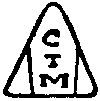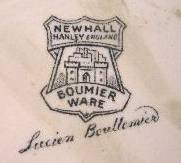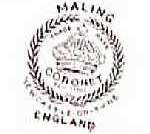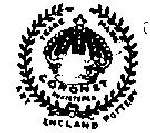Factory Marks
These are a few of the two dozen or so marks used by the factory from the 1800s onwards. Some variations are noted in the captions.
In brief, your piece may be marked "England" rather than "Made in England", or it may say "Newcastle" rather than "Newcastle-on-Tyne". Don't be worried. If it says "Maling", then it probably is.
There is information on Coronet Ware and Boumier Ware at the bottom of the page.
|
Impressed mark used after the factory moved to Newcastle in 1817. The names "Maling" and "Robert Maling" may also be found impressed in a straight line.
|

|
|
The "bell in wreath" transfer was used by both Robert Maling and his son. It survives into the 1890s. (Obviously, the initials changed from RM to CTM.) Sometimes the bell does not appear.
|

|
|
An impressed C.T. MALING mark used from circa 1853,
when C.T. Maling took over the factory.
|

|
|
The impressed CTM triangle mark first used in
the last quarter of the 19th century but surviving through into
the early years of the 20th century.
|

|
|
The transfer printed CTM triangle mark: dates
as above. (Christopher Thompson Maling died in 1901.) The subsequent "Cetem" mark (see below) is a phonetic tribute to C.T. Maling & Sons.
|

|
|
Castle surrounded by sunburst and "Cetem Ware",
first registered in 1908 and used through until the 1930s. Also
found without the sunburst, particularly on whitewares such as jelly
moulds.
|

|
|
A typical Maling castle mark used from the 1920s
through to the factory's closure in 1963. Several variations exist, and the words "Estd 1762", "'Newcastle-on-Tyne", or "Made in England" may or may not accompany the castle.
|

|
|
A mark frequently found on 1930s/40s pieces,
including "Art" wares, plaques and commemoratives.
|

|
Coronet Ware
There has been confusion over the following marks which are found on
"Coronet" wares imported by the USA in the late 20s:
If it says "Maling" (as in the example on the left) then it is. If it
looks similar (as in the example on the right) but doesn't say "Maling"
- it isn't! Several other potteries also made Coronet Ware
The numbers on Coronet are generally in the form of xxx/yyyy. They bear no relation to those on other Maling. Records have been lost, and we have no idea what they mean.
Boumier Ware
 Designer L.E.
Boullemier left Maling in 1936 for the New Hall factory in Staffordshire
- where they encouraged him to "sign" his wares with this mark and facsimile
signature. If anyone tells you that these signed piece are "rare" and
therefore valuable, tell them that you beg to differ. Designer L.E.
Boullemier left Maling in 1936 for the New Hall factory in Staffordshire
- where they encouraged him to "sign" his wares with this mark and facsimile
signature. If anyone tells you that these signed piece are "rare" and
therefore valuable, tell them that you beg to differ.
|










 Designer L.E.
Boullemier left Maling in 1936 for the New Hall factory in Staffordshire
- where they encouraged him to "sign" his wares with this mark and facsimile
signature. If anyone tells you that these signed piece are "rare" and
therefore valuable, tell them that you beg to differ.
Designer L.E.
Boullemier left Maling in 1936 for the New Hall factory in Staffordshire
- where they encouraged him to "sign" his wares with this mark and facsimile
signature. If anyone tells you that these signed piece are "rare" and
therefore valuable, tell them that you beg to differ.